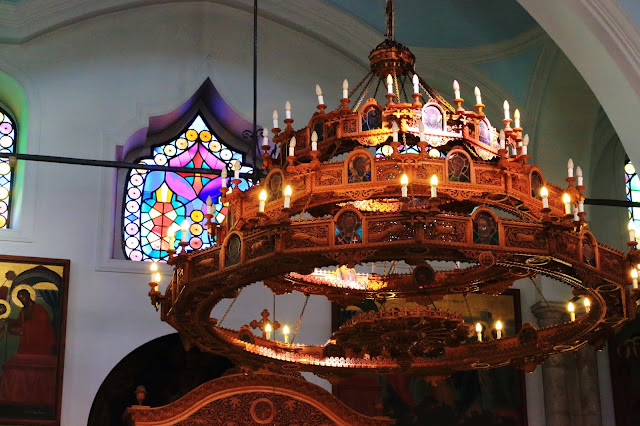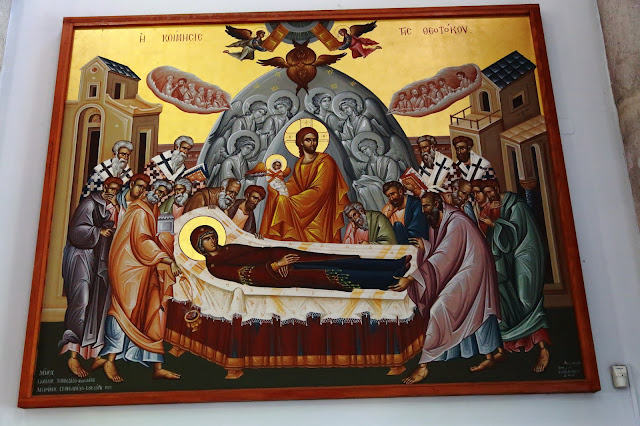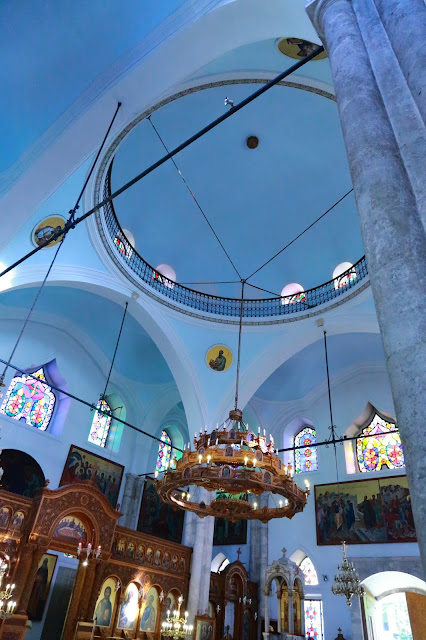"The true son of the common faith". Travelogue about the island of Crete. The Church Of St. Titus. Heraklion.
«Истинный сын по общей вере». Путевые заметки об острове Крит. Храм Святого Тита. Ираклион.
I think I will not be mistaken if I say that any traveler who has visited
Heraklion in Crete, if not went inside, then at least passed by the Church of
the Holy Apostle Titus.
Я думаю, что
не ошибусь, если буду утверждать, что любой путешественник, побывавший в
Ираклионе на Крите, если не заходил внутрь, то, по крайней мере, проходил мимо
Храма Святого Апостола Тита.
The temple was built to replace the destroyed by Muslims temple in Gortyn
at the direction of Nikifor II FokI, commander, and later the Emperor of
Byzantium, who liberated the island from the Saracens. Gortina was the first city in Crete to adopt
Christianity. The formation of Christianity in Crete is associated with the
name of Titus the Apostle of the seventy – a disciple of the Apostle Paul. The
Apostle Titus became the first Bishop of Crete. He was appointed to this post
by the Apostle Paul. From the Holy Scriptures, we know that Titus was fulfilling his mentor's
instructions, establishing in the faith local churches. The apostle Titus
executed the commissioner - he founded nine dioceses in Crete, died in a very
old age and was buried in the city of Gortina. In the 6th century, a majestic
basilica was built in his honor, and here his holy relics were kept. After the devastation of the island by the Saracens in the IX century, the
relics of the Apostle Titus left one head.
Храм был
построен взамен разрушенного мусульманами храма в Гортине по указанию Никифора II Фоки,
военачальника, а в последствии и императора Византии, освободившего остров от
сарацин. Гортина была первым городом на Крите, который принял
христианство. Становление Христианства на Крите связано с именем Тита – апостола
от семидесяти – ученика апостола Павла. Апостол Тит стал первым епископом
Крита. На этот пост он был поставлен Апостолом Павлом. Из Священного Писания мы
знаем, что Тит выполнял поручения своего наставника, утверждая в вере местные
церкви. Апостол Тит исполнил порученное - основал на Крите девять епархий,
умер в глубокой старости и был погребён в городе Гортина. В VI веке была
возведена величественная базилика в его честь, здесь же хранились его святые
мощи. После опустошения острова сарацинами в IX веке от мощей апостола
Тита осталась одна глава.
A Gentile of the original, Titus was
converted to Christianity by the Holy Apostle Paul, who calls him "the
true son of the common faith" (Titus 1: 4). A few years later, about 49
years later, they met again in Antioch. Paul took him and Barnabas with him to
Jerusalem to report to the apostles in his missionary work among the Gentiles. From that time on, he
accompanied the Apostle on missionary journeys and became one of his closest
associates.
Язычник изначала, Тит был обращён в христианство святым
апостолом Павлом, который называет его «истинным сыном по общей вере» (Тит 1:
4). Несколько лет спустя, около 49 года, они вновь встретились в Антиохии.
Павел взял его и Варнаву с собой в Иерусалим, чтобы отчитаться перед апостолами
в своей миссионерской деятельности среди язычников. С этого времени он
сопровождает апостола в миссионерских путешествиях и становится одним из его
наиболее близких сотрудников.
Titus was with the Holy Apostle Paul in Rome during his
first imprisonment and accompanied him on his return journey to the East. Moored
to the island of Crete, they preached the Good News together in many cities. Paul,
who was to continue the voyage, left Titus to complete the construction of the
new Church and for this to place a Bishop in each city (Titus 1: 5-7). Titus
met strong opposition, especially from the Jews, and wrote to Paul. He in his
answer encourages Titus to teach everything that is in accordance with"
sound doctrine "(Titus 2: 1), and his behavior to set an example,
and" in teaching purity, sedentary, intact, the word sound, unrecognized
"that his opponents, the distributors of" Jewish fables... averse
from the truth", could not say anything about the disciples of Christ
thin, being filled with confusion (see: Titus 2: 7-8 and 1: 14).
Тит находился со святым апостолом Павлом в
Риме во время его первого заключения и сопровождал во время обратного
путешествия на Восток. Причалив к острову Крит, они вместе проповедовали Благую
Весть во многих городах. Павел, который должен был продолжать плавание, оставил
Тита завершать устройство новой Церкви (около 63 г.) и для этого поставить в
каждом городе епископа (Тит 1: 5–7). Тит встретил сильное сопротивление,
особенно со стороны иудеев, и написал Павлу. Тот в своем ответе побуждает Тита
учить всему, что находится в соответствии «со здравым учением» (Тит 2: 1), и
своим поведением показывать пример, а «в учительстве чистоту, степенность,
неповрежденность, слово здравое, неукоризненное», чтобы его противники,
распространители «иудейских басен… отвращающиеся от истины», не могли ничего
сказать об учениках Христовых худого, будучи исполнены замешательства (см.: Тит
2: 7–8 и 1: 14).
After the martyrdom of the Apostle Paul, Titus
returned to Crete, where he was received by the inhabitants with glee, but soon
learned that they had retained pagan customs. Then the Apostle threw the
statue of Artemis on the earth in the name of Jesus Christ. In the face of this
miracle, more than five hundred pagans cried out, "Great is the God
preached by Titus!"and they believed in Christ. Saint Titus, having established
the seat of the Episcopal pulpit in Gortyn, appointed nine new bishops for the
main cities of Crete. He asserted the true faith both by word and by miracles.
When the Apostle was 94 years old, his death hour came. The Bishop's abode was
suddenly filled with a fragrant cloud, and many angels appeared to help him. With
his face shining like the sun, Holy Titus betrayed the spirit to God, saying
these words: "Lord, I have kept the faith and established Your people in
your fear. Take my spirit now!» When his body, in the white vestments, carried
to burial, pagan temples collapsed. Later at his grave healed many possessed.
His body was laid in the main temple of the city of
Gortyna, where his pulpit was located. There he was revered for centuries as the
protector of the Cretan Church.
После мученической кончины апостола Павла
Тит вернулся на Крит, где был принят жителями с ликованием, но вскоре узнал,
что они сохранили языческие обычаи. Тогда апостол поверг статую Артемиды на
землю именем Иисуса Христа. Перед лицом этого чуда более пяти сотен язычников
вскричали: «Велик Бог, Которого проповедует Тит!» – и уверовали во Христа.
Святой Тит, установив местопребывание епископской кафедры в Гортине, поставил
девять новых епископов для главных городов Крита. Он утверждал истинную веру
как словом, так и чудесами. Когда апостолу исполнилось 94 года, подошёл его
смертный час. Жилище епископа внезапно заполнило благовонное облако, и
множество ангелов появились помочь ему. С лицом, сияющим как солнце, святой Тит
предал дух Богу, произнеся такие слова: «Господи, я хранил веру и утвердил
народ Твой в страхе Твоём. Прими ныне дух мой!» Когда его тело, в белом
облачении, несли к погребению, языческие храмы обрушились. Впоследствии у его
могилы исцелилось множество одержимых.
Его тело было положено в главном храме
города Гортины, где находилась его кафедра. Там он почитался в течение многих
веков как защитник Критской Церкви.
When the island was liberated from the
Arab invaders, the capital was moved to Candia (Heraklion), and there was built
a new Cathedral in the name of St. Titus. This Church remained the main place
of pilgrimage in Crete throughout the dominion of the Venetians (1210-1669). During
the Venetian rule the Cathedral was the Cathedral of the Catholic Archbishop.
During the Turkish rule the building of the temple was converted into a mosque.
After the Turkish minority left Crete in 1923, the Cathedral was again
consecrated as an Orthodox Church and the minaret was converted into a bell
tower. The fact that the temple passed from hand to hand, determined the
uniqueness of its architecture. . In 1966, cancer with the relics of the Holy
Apostle Titus, taken from Crete to Italy by General Morosini shortly before the
conquest of the town by the Turks, was returned again to the island from
Venice. Currently, the relics of the Apostle
are stored in the Cathedral of St. Titus in Heraklion, to the left of the
entrance.
Когда остров был освобождён от арабских захватчиков, столица была
перенесена в Кандию (Ираклион), и там был построен новый собор во имя святого
Тита. Эта церковь оставалась главным местом паломничества на Крите на
протяжении всего владычества венецианцев (1210–1669). В период венецианского господства собор был
кафедральным храмом католического архиепископа. Во время турецкого
владычества здание храма было переоборудовано в мечеть. После
того как в 1923 году турецкое меньшинство покинуло Крит, собор вновь
был освящён как православный храм, а минарет переделан в колокольню. То,
что храм переходил из рук в руки, определило уникальность его
архитектуры. В 1966 году рака с мощами св. апостола Тита, вывезенная с
Крита в Италию генералом Морозини незадолго до завоевания городка турками, была
возвращена опять на остров из Венеции. В настоящее
время мощи апостола хранятся в Соборе Святого Тита в Ираклионе, слева от входа.

























Комментариев нет:
Отправить комментарий